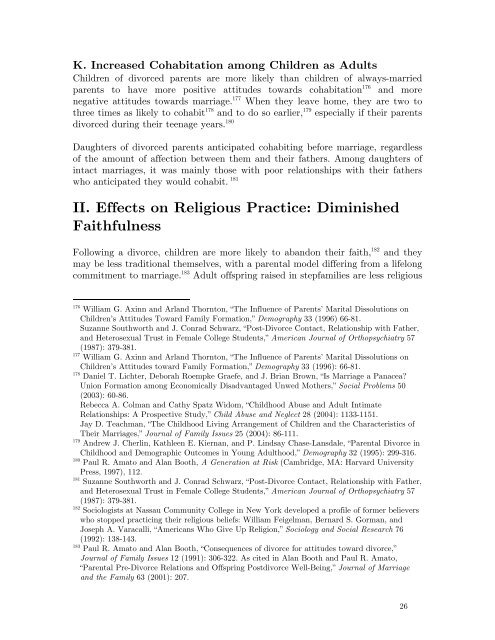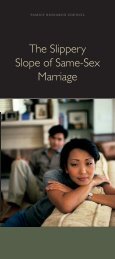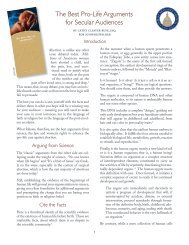The Effects of Divorce on Children - Family Research Council
The Effects of Divorce on Children - Family Research Council
The Effects of Divorce on Children - Family Research Council
Create successful ePaper yourself
Turn your PDF publications into a flip-book with our unique Google optimized e-Paper software.
K. Increased Cohabitati<strong>on</strong> am<strong>on</strong>g <strong>Children</strong> as Adults<br />
<strong>Children</strong> <str<strong>on</strong>g>of</str<strong>on</strong>g> divorced parents are more likely than children <str<strong>on</strong>g>of</str<strong>on</strong>g> always-married<br />
parents to have more positive attitudes towards cohabitati<strong>on</strong> 176 and more<br />
negative attitudes towards marriage. 177 When they leave home, they are two to<br />
three times as likely to cohabit 178 and to do so earlier, 179 especially if their parents<br />
divorced during their teenage years. 180<br />
Daughters <str<strong>on</strong>g>of</str<strong>on</strong>g> divorced parents anticipated cohabiting before marriage, regardless<br />
<str<strong>on</strong>g>of</str<strong>on</strong>g> the amount <str<strong>on</strong>g>of</str<strong>on</strong>g> affecti<strong>on</strong> between them and their fathers. Am<strong>on</strong>g daughters <str<strong>on</strong>g>of</str<strong>on</strong>g><br />
intact marriages, it was mainly those with poor relati<strong>on</strong>ships with their fathers<br />
who anticipated they would cohabit. 181<br />
II. <str<strong>on</strong>g>Effects</str<strong>on</strong>g> <strong>on</strong> Religious Practice: Diminished<br />
Faithfulness<br />
Following a divorce, children are more likely to aband<strong>on</strong> their faith, 182 and they<br />
may be less traditi<strong>on</strong>al themselves, with a parental model differing from a lifel<strong>on</strong>g<br />
commitment to marriage. 183 Adult <str<strong>on</strong>g>of</str<strong>on</strong>g>fspring raised in stepfamilies are less religious<br />
176<br />
William G. Axinn and Arland Thornt<strong>on</strong>, “<str<strong>on</strong>g>The</str<strong>on</strong>g> Influence <str<strong>on</strong>g>of</str<strong>on</strong>g> Parents’ Marital Dissoluti<strong>on</strong>s <strong>on</strong><br />
<strong>Children</strong>’s Attitudes Toward <strong>Family</strong> Formati<strong>on</strong>,” Demography 33 (1996) 66-81.<br />
Suzanne Southworth and J. C<strong>on</strong>rad Schwarz, “Post-<str<strong>on</strong>g>Divorce</str<strong>on</strong>g> C<strong>on</strong>tact, Relati<strong>on</strong>ship with Father,<br />
and Heterosexual Trust in Female College Students,” American Journal <str<strong>on</strong>g>of</str<strong>on</strong>g> Orthopsychiatry 57<br />
(1987): 379-381.<br />
177<br />
William G. Axinn and Arland Thornt<strong>on</strong>, “<str<strong>on</strong>g>The</str<strong>on</strong>g> Influence <str<strong>on</strong>g>of</str<strong>on</strong>g> Parents’ Marital Dissoluti<strong>on</strong>s <strong>on</strong><br />
<strong>Children</strong>’s Attitudes toward <strong>Family</strong> Formati<strong>on</strong>,” Demography 33 (1996): 66-81.<br />
178<br />
Daniel T. Lichter, Deborah Roempke Graefe, and J. Brian Brown, “Is Marriage a Panacea?<br />
Uni<strong>on</strong> Formati<strong>on</strong> am<strong>on</strong>g Ec<strong>on</strong>omically Disadvantaged Unwed Mothers,” Social Problems 50<br />
(2003): 60-86.<br />
Rebecca A. Colman and Cathy Spatz Widom, “Childhood Abuse and Adult Intimate<br />
Relati<strong>on</strong>ships: A Prospective Study,” Child Abuse and Neglect 28 (2004): 1133-1151.<br />
Jay D. Teachman, “<str<strong>on</strong>g>The</str<strong>on</strong>g> Childhood Living Arrangement <str<strong>on</strong>g>of</str<strong>on</strong>g> <strong>Children</strong> and the Characteristics <str<strong>on</strong>g>of</str<strong>on</strong>g><br />
<str<strong>on</strong>g>The</str<strong>on</strong>g>ir Marriages,” Journal <str<strong>on</strong>g>of</str<strong>on</strong>g> <strong>Family</strong> Issues 25 (2004): 86-111.<br />
179<br />
Andrew J. Cherlin, Kathleen E. Kiernan, and P. Lindsay Chase-Lansdale, “Parental <str<strong>on</strong>g>Divorce</str<strong>on</strong>g> in<br />
Childhood and Demographic Outcomes in Young Adulthood,” Demography 32 (1995): 299-316.<br />
180<br />
Paul R. Amato and Alan Booth, A Generati<strong>on</strong> at Risk (Cambridge, MA: Harvard University<br />
Press, 1997), 112.<br />
181<br />
Suzanne Southworth and J. C<strong>on</strong>rad Schwarz, “Post-<str<strong>on</strong>g>Divorce</str<strong>on</strong>g> C<strong>on</strong>tact, Relati<strong>on</strong>ship with Father,<br />
and Heterosexual Trust in Female College Students,” American Journal <str<strong>on</strong>g>of</str<strong>on</strong>g> Orthopsychiatry 57<br />
(1987): 379-381.<br />
182<br />
Sociologists at Nassau Community College in New York developed a pr<str<strong>on</strong>g>of</str<strong>on</strong>g>ile <str<strong>on</strong>g>of</str<strong>on</strong>g> former believers<br />
who stopped practicing their religious beliefs: William Feigelman, Bernard S. Gorman, and<br />
Joseph A. Varacalli, “Americans Who Give Up Religi<strong>on</strong>,” Sociology and Social <strong>Research</strong> 76<br />
(1992): 138-143.<br />
183<br />
Paul R. Amato and Alan Booth, “C<strong>on</strong>sequences <str<strong>on</strong>g>of</str<strong>on</strong>g> divorce for attitudes toward divorce,”<br />
Journal <str<strong>on</strong>g>of</str<strong>on</strong>g> <strong>Family</strong> Issues 12 (1991): 306-322. As cited in Alan Booth and Paul R. Amato,<br />
“Parental Pre-<str<strong>on</strong>g>Divorce</str<strong>on</strong>g> Relati<strong>on</strong>s and Offspring Postdivorce Well-Being,” Journal <str<strong>on</strong>g>of</str<strong>on</strong>g> Marriage<br />
and the <strong>Family</strong> 63 (2001): 207.<br />
26




